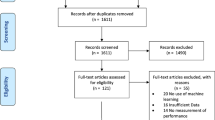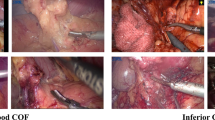Abstract
Machine learning (ML) models are being actively used in modern medicine, including neurosurgery. This study aimed to summarize the current applications of ML in the analysis and assessment of neurosurgical skills. We conducted this systematic review in accordance with the Preferred Reporting Items for Systematic Reviews and Meta-Analyses (PRISMA) guidelines. We searched the PubMed and Google Scholar databases for eligible studies published until November 15, 2022, and used the Medical Education Research Study Quality Instrument (MERSQI) to assess the quality of the included articles. Of the 261 studies identified, we included 17 in the final analysis. Studies were most commonly related to oncological, spinal, and vascular neurosurgery using microsurgical and endoscopic techniques. Machine learning-evaluated tasks included subpial brain tumor resection, anterior cervical discectomy and fusion, hemostasis of the lacerated internal carotid artery, brain vessel dissection and suturing, glove microsuturing, lumbar hemilaminectomy, and bone drilling. The data sources included files extracted from VR simulators and microscopic and endoscopic videos. The ML application was aimed at classifying participants into several expertise levels, analysis of differences between experts and novices, surgical instrument recognition, division of operation into phases, and prediction of blood loss. In two articles, ML models were compared with those of human experts. The machines outperformed humans in all tasks. The most popular algorithms used to classify surgeons by skill level were the support vector machine and k-nearest neighbors, and their accuracy exceeded 90%. The “you only look once” detector and RetinaNet usually solved the problem of detecting surgical instruments — their accuracy was approximately 70%. The experts differed by more confident contact with tissues, higher bimanuality, smaller distance between the instrument tips, and relaxed and focused state of the mind. The average MERSQI score was 13.9 (from 18). There is growing interest in the use of ML in neurosurgical training. Most studies have focused on the evaluation of microsurgical skills in oncological neurosurgery and on the use of virtual simulators; however, other subspecialties, skills, and simulators are being investigated. Machine learning models effectively solve different neurosurgical tasks related to skill classification, object detection, and outcome prediction. Properly trained ML models outperform human efficacy. Further research on ML application in neurosurgery is needed.

Similar content being viewed by others
Availability of data and materials
Not applicable.
References
Sharma R, Suri A (2022) Microsurgical suturing assessment scores: a systematic review. Neurosurg Rev 45:119–124. https://doi.org/10.1007/s10143-021-01569-3
Stogowski P, Fliciński F, Białek J, Dąbrowski F, Piotrowski M, Mazurek T (2021) Microsurgical Anastomosis Rating Scale (MARS10): a final product scoring system for initial microsurgical training. Plast Surg (Oakville, Ont) 29:243–249. https://doi.org/10.1177/2292550320969649
Manjul S, Bettag M, Roy TS, Lalwani SAT (2016) Simulation based skills training in neurosurgery and contemporary surgical practices. Ann Natl Acad Med Sci 52:56–75. https://doi.org/10.1055/s-0040-1712607
Aghazadeh MA, Jayaratna IS, Hung AJ, Pan MM, Desai MM, Gill IS, Goh AC (2015) External validation of Global Evaluative Assessment of Robotic Skills (GEARS). Surg Endosc 29:3261–3266. https://doi.org/10.1007/s00464-015-4070-8
Liu M, Purohit S, Mazanetz J, Allen W, Kreaden US, Curet M (2018) Assessment of Robotic Console Skills (ARCS): construct validity of a novel global rating scale for technical skills in robotically assisted surgery. Surg Endosc 32:526–535. https://doi.org/10.1007/s00464-017-5694-7
Wagner MW, Namdar K, Biswas A, Monah S, Khalvati F, Ertl-Wagner BB (2021) Radiomics, machine learning, and artificial intelligence-what the neuroradiologist needs to know. Neuroradiology 63:1957–1967. https://doi.org/10.1007/s00234-021-02813-9
Javidan AP, Li A, Lee MH, Forbes TL, Naji F (2022) A systematic review and bibliometric analysis of applications of artificial intelligence and machine learning in vascular surgery. Ann Vasc Surg 85:395–405. https://doi.org/10.1016/j.avsg.2022.03.019
Lalehzarian SP, Gowd AK, Liu JN (2021) Machine learning in orthopaedic surgery. World J Orthop 12:685–699. https://doi.org/10.5312/wjo.v12.i9.685
Sakamoto T, Goto T, Fujiogi M, Kawarai Lefor A (2022) Machine learning in gastrointestinal surgery. Surg Today 52:995–1007. https://doi.org/10.1007/s00595-021-02380-9
Kaka H, Zhang E, Khan N (2021) Artificial intelligence and deep learning in neuroradiology: exploring the new frontier. Can Assoc Radiol J = J l’Association Can des Radiol 72:35–44. https://doi.org/10.1177/0846537120954293
Witten AJ, Patel N, Cohen-Gadol A (2022) Image segmentation of operative neuroanatomy into tissue categories using a machine learning construct and its role in neurosurgical training. Oper Neurosurg (Hagerstown, Md) 23:279–286. https://doi.org/10.1227/ons.0000000000000322
Liberati A, Altman DG, Tetzlaff J, Mulrow C, Gøtzsche PC, Ioannidis JPA, Clarke M, Devereaux PJ, Kleijnen J, Moher D (2009) The PRISMA statement for reporting systematic reviews and meta-analyses of studies that evaluate healthcare interventions: explanation and elaboration. BMJ 339:b2700. https://doi.org/10.1136/bmj.b2700
Shea BJ, Reeves BC, Wells G, Thuku M, Hamel C, Moran J, Moher D, Tugwell P, Welch V, Kristjansson E, Henry DA (2017) AMSTAR 2: a critical appraisal tool for systematic reviews that include randomised or non-randomised studies of healthcare interventions, or both. BMJ 358:j4008. https://doi.org/10.1136/bmj.j4008
Bramer WM, Rethlefsen ML, Kleijnen J, Franco OH (2017) Optimal database combinations for literature searches in systematic reviews: a prospective exploratory study. Syst Rev 6:245. https://doi.org/10.1186/s13643-017-0644-y
Cook DA, Reed DA (2015) Appraising the quality of medical education research methods: the medical education research study quality instrument and the Newcastle-Ottawa scale-education. Acad Med 90:1067–1076. https://doi.org/10.1097/ACM.0000000000000786
Reed DA, Cook DA, Beckman TJ, Levine RB, Kern DE, Wright SM (2007) Association between funding and quality of published medical education research. JAMA 298:1002–1009. https://doi.org/10.1001/jama.298.9.1002
Kumar S (2019) Evidence in surgery—levels and significance. Indian J Surg 81:307–316. https://doi.org/10.1007/s12262-019-01939-8
Bissonnette V, Mirchi N, Ledwos N, Alsidieri G, Winkler-Schwartz A, Del Maestro RF (2019) Artificial intelligence distinguishes surgical training levels in a virtual reality spinal task. J Bone Joint Surg Am 101:e127. https://doi.org/10.2106/JBJS.18.01197
Winkler-Schwartz A, Yilmaz R, Mirchi N, Bissonnette V, Ledwos N, Siyar S, Azarnoush H, Karlik B, Del Maestro R (2019) Machine learning identification of surgical and operative factors associated with surgical expertise in virtual reality simulation. JAMA Netw open 2:e198363. https://doi.org/10.1001/jamanetworkopen.2019.8363
Mirchi N, Bissonnette V, Ledwos N, Winkler-Schwartz A, Yilmaz R, Karlik B, Del Maestro RF (2020) Artificial neural networks to assess virtual reality anterior cervical discectomy performance. Oper Neurosurg 19:65–75
Mirchi N, Bissonnette V, Yilmaz R, Ledwos N, Winkler-Schwartz A, Del Maestro RF (2020) The virtual operative assistant: an explainable artificial intelligence tool for simulation-based training in surgery and medicine. PLoS One 15:e0229596. https://doi.org/10.1371/journal.pone.0229596
Siyar S, Azarnoush H, Rashidi S, Winkler-Schwartz A, Bissonnette V, Ponnudurai N, Del Maestro RF (2020) Machine learning distinguishes neurosurgical skill levels in a virtual reality tumor resection task. Med Biol Eng Comput 58:1357–1367. https://doi.org/10.1007/s11517-020-02155-3
Alkadri S, Ledwos N, Mirchi N, Reich A, Yilmaz R, Driscoll M, Del Maestro RF (2021) Utilizing a multilayer perceptron artificial neural network to assess a virtual reality surgical procedure. Comput Biol Med 136:104770. https://doi.org/10.1016/j.compbiomed.2021.104770
Davids J, Makariou S-G, Ashrafian H, Darzi A, Marcus HJ, Giannarou S (2021) Automated vision-based microsurgical skill analysis in neurosurgery using deep learning: development and preclinical validation. World Neurosurg 149:e669–e686. https://doi.org/10.1016/j.wneu.2021.01.117
Khan DZ, Luengo I, Barbarisi S, Addis C, Culshaw L, Dorward NL, Haikka P, Jain A, Kerr K, Koh CH (2021) Automated operative workflow analysis of endoscopic pituitary surgery using machine learning: development and preclinical evaluation (IDEAL stage 0). J Neurosurg 1:1–8
Fazlollahi AM, Bakhaidar M, Alsayegh A, Yilmaz R, Winkler-Schwartz A, Mirchi N, Langleben I, Ledwos N, Sabbagh AJ, Bajunaid K, Harley JM, Del Maestro RF (2022) Effect of artificial intelligence tutoring vs expert instruction on learning simulated surgical skills among medical students: a randomized clinical trial. JAMA Netw open 5:e2149008. https://doi.org/10.1001/jamanetworkopen.2021.49008
Koskinen J, Torkamani-Azar M, Hussein A, Huotarinen A, Bednarik R (2022) Automated tool detection with deep learning for monitoring kinematics and eye-hand coordination in microsurgery. Comput Biol Med 141:105121. https://doi.org/10.1016/j.compbiomed.2021.105121
Ledwos N, Mirchi N, Yilmaz R, Winkler-Schwartz A, Sawni A, Fazlollahi AM, Bissonnette V, Bajunaid K, Sabbagh AJ, Del Maestro RF (2022) Assessment of learning curves on a simulated neurosurgical task using metrics selected by artificial intelligence. J Neurosurg 1–12. https://doi.org/10.3171/2021.12.JNS211563
Natheir S, Christie S, Yilmaz R, Winkler-Schwartz A, Bajunaid K, Sabbagh AJ, Werthner P, Fares J, Azarnoush H, Del Maestro R (2023) Utilizing artificial intelligence and electroencephalography to assess expertise on a simulated neurosurgical task. Comput Biol Med 152:106286. https://doi.org/10.1016/j.compbiomed.2022.106286
Pangal DJ, Kugener G, Zhu Y, Sinha A, Unadkat V, Cote DJ, Strickland B, Rutkowski M, Hung A, Anandkumar A, Han XY, Papyan V, Wrobel B, Zada G, Donoho DA (2022) Expert surgeons and deep learning models can predict the outcome of surgical hemorrhage from 1 min of video. Sci Rep 12:8137. https://doi.org/10.1038/s41598-022-11549-2
Reich A, Mirchi N, Yilmaz R, Ledwos N, Bissonnette V, Tran DH, Winkler-Schwartz A, Karlik B, Del Maestro RF (2022) Artificial neural network approach to competency-based training using a virtual reality neurosurgical simulation. Oper Neurosurg (Hagerstown, Md) 23:31–39. https://doi.org/10.1227/ons.0000000000000173
Unadkat V, Pangal DJ, Kugener G, Roshannai A, Chan J, Zhu Y, Markarian N, Zada G, Donoho DA (2022) Code-free machine learning for object detection in surgical video: a benchmarking, feasibility, and cost study. Neurosurg Focus 52:E11
Yilmaz R, Winkler-Schwartz A, Mirchi N, Reich A, Christie S, Tran DH, Ledwos N, Fazlollahi AM, Santaguida C, Sabbagh AJ, Bajunaid K, Del Maestro R (2022) Continuous monitoring of surgical bimanual expertise using deep neural networks in virtual reality simulation. NPJ Digit Med 5:54. https://doi.org/10.1038/s41746-022-00596-8
Kugener G, Pangal DJ, Cardinal T, Collet C, Lechtholz-Zey E, Lasky S, Sundaram S, Markarian N, Zhu Y, Roshannai A (2022) Utility of the simulated outcomes following carotid artery laceration video data set for machine learning applications. JAMA Netw open 5:e223177–e223177
Bhandari M, Zeffiro T, Reddiboina M (2020) Artificial intelligence and robotic surgery: current perspective and future directions. Curr Opin Urol 30:48–54. https://doi.org/10.1097/MOU.0000000000000692
Howard J (2019) Artificial intelligence: implications for the future of work. Am J Ind Med 62:917–926. https://doi.org/10.1002/ajim.23037
Turing AM (1950) I.—Computing machinery and intelligence. Mind LIX:433–460. Springer. https://doi.org/10.1093/mind/LIX.236.433
McCarthy J, Minsky ML, Rochester N, Shannon CE (2006) A proposal for the dartmouth summer research project on artificial intelligence, august 31, 1955. AI Mag 27:12
ROSENBLATT F (1958) The perceptron: a probabilistic model for information storage and organization in the brain. Psychol Rev 65:386–408. doi: https://doi.org/10.1037/h0042519
Samuel AL (1988) In: Levy DNL (ed) Some studies in machine learning using the game of checkers. II—Recent Progress BT - Computer Games I. Springer New York, New York, NY, pp 366–400
Schilling AT, Shah PP, Feghali J, Jimenez AE, Azad TD (2022) A brief history of machine learning in neurosurgery. Acta Neurochir Suppl 134:245–250. https://doi.org/10.1007/978-3-030-85292-4_27
Crossnohere NL, Elsaid M, Paskett J, Bose-Brill S, Bridges JFP (2022) Guidelines for artificial intelligence in medicine: literature review and content analysis of frameworks. J Med Internet Res 24:e36823. https://doi.org/10.2196/36823
Funding
This work was supported by the Russian Science Foundation grant № 22-75-10117.
Author information
Authors and Affiliations
Contributions
O.T.: study design, material preparation, data collection and analysis, and manuscript writing
A.B.: study design, data collection and analysis, and manuscript writing
D.P.: study design, data analysis, and general supervision
All authors read and approved the final manuscript.
Corresponding author
Ethics declarations
Ethical approval
This is a review study. No ethical approval is required.
Competing interests
The authors declare no competing interests.
Additional information
Publisher’s note
Springer Nature remains neutral with regard to jurisdictional claims in published maps and institutional affiliations.
No portion of the paper has been presented or published previously.
Rights and permissions
Springer Nature or its licensor (e.g. a society or other partner) holds exclusive rights to this article under a publishing agreement with the author(s) or other rightsholder(s); author self-archiving of the accepted manuscript version of this article is solely governed by the terms of such publishing agreement and applicable law.
About this article
Cite this article
Titov, O., Bykanov, A. & Pitskhelauri, D. Neurosurgical skills analysis by machine learning models: systematic review. Neurosurg Rev 46, 121 (2023). https://doi.org/10.1007/s10143-023-02028-x
Received:
Revised:
Accepted:
Published:
DOI: https://doi.org/10.1007/s10143-023-02028-x




